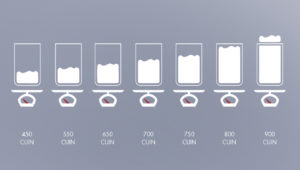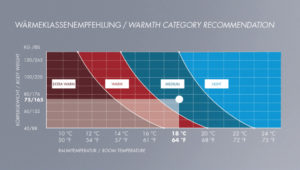Are you also one of those people who use a different duvet in winter than in summer? Are you grateful that, for example, on a summer holiday in Spain you have a bed sheet, but on a winter holiday in Austria you have a down duvet in your hotel bed? Then you already know that different room temperatures require duvets of different warmth classes.
But what are warmth classes actually? Wie sind sie definiert? Which warmth classes are there? What factors determine the warmth class of a duvet? How do I find out which is the right warmth class for me?
In the following article we address all these questions. And show you how to find the right warmth class for you.
How are the warmth classes defined?

How warming a duvet is, is usually indicated in so-called togs. This is a unit that indicates how much of the body heat the blanket is able to retain. In principle, the specification of the togs gives a good guideline for the selection of a blanket. However, it is not an absolute measure – e.g. because it does not capture one of the key advantages of a down duvet, that it is insulating by nature.
What is a tog?
Tog is a unit of thermal resistance used to measure the insulating properties of bedding, including duvets and duvets. The tog number indicates the degree of warmth of a duvet, with a higher tog number representing better insulation and more warmth. Tog values usually range from 1 (very light) to 15 (very warm).
What does the CUIN value say about down duvets?
The filling power is the primary scientific standard for the quality of the down. The higher the filling power – the so-called CUIN value – the better the quality of a duvet: for the same weight, down with high CUIN values has a higher heat retention. They can trap and insulate more air. They are also more voluminous, puffier and therefore fluffier. The duvet is perceptibly lighter with the same thermal performance. The best duvet is the one which has the highest thermal insulation property at the lowest weight.
What does the warmth class of a blanket depend on?
The warmth of a blanket does not depend solely on the filling weight of the blanket. Other important factors are, for example, the type of filling, its quality and, in the case of down duvets, the filling power or CUIN value.
What fillings are available?
Vicuña
The wool of the small camel is incomparably fine and soft. Bedding filled with vicuña wool convince by absolute lightness with highest fill power and provide an extraordinarily pleasant sleeping climate. Due to the unique softness, Vicuña bedding is extraordinarily cuddly and caresses the sleeper night after night with a touch of tender luxury.
Camel Hair
Camel hair fillings make blanket incredibly light and cuddly and gives them excellent thermal insulation as well as the property to transport moisture quickly. Together with the fine cover material, this creates a pleasant and supple sleeping sensation. Camel hair blankets are particularly suitable for people who generate a lot of heat themselves and sweat easily. They are also optimal for sleeping in warm and hot environments.
Bamboo
Bamboo fibre is a wonderful, unique filling for duvets. It is very soft, very absorbent and regulates the temperature in an excellent way – perfect for summer! Due to the softness of the material and because of the unique body zone quilting, bamboo blankets also nestle wonderfully against the body.
Cashmere
Cashmere is – after Vicuña – the second finest and most valuable natural hair filling. The very fine, well-curled downy hairs in this high-quality blanket are particularly soft, supple and so cosy. A little luxury that you never want to do without.
Wild Silk
Wild silk is a fine, skin-friendly natural fiber. The moisture absorption is enormous. Wild silk blankets are ideal for people with low heat requirements as well as the warm season.
Which warmth classes are there?
A distinction is usually made between the four warmth classes of light, medium, warm and extra warm. These cover the range from 2.5 to 13.5 Tog.
Light (2.5 – 4 Tog)
These light and airy blankets are especially suitable for the warm season and for people with a low heat requirement.
An example of a “light” duvet is our bamboo summer duvet. The vegan bamboo fibre it contains is a wonderful, unique filling for duvets. It is very soft, very absorbent and regulates the temperature in the best way. Thanks to the special softness of the material and the unique body zone quilting, it nestles wonderfully against the body.
People who tend to sweat a lot when sleeping should take a look at our CLIMABALANCE® First Class down duvet. This technology keeps you dry and warm without accumulating moisture or heat. The CLIMABALANCE® climate zones always provide a dry sleeping climate at a pleasant temperature.
Medium (6 – 8 Tog)
Medium includes normal warming blankets, which most people prefer for spring, autumn and even all year round, depending on the indoor climate.
A good example of such a blanket is the Princess 800 down blanket. This blanket is made of First Class down from the most exquisite provenances with a bulking power of 800 CUIN! This makes this duvet particularly light and fluffy and ensures a uniquely refined sleeping experience.
Warm (8 – 11 Tog)
Warm blankets are very warm and cosy. This makes them typical winter blankets and well suited for people who get cold quickly.
An excellent example of such a warm blanket is our Österreichische Weidegans Down Blanket. Under the quality label “Österreichische Weidegans”, Austrian farmers breed geese in a species-appropriate manner with plenty of outdoor space on species-appropriate meadows. One of the ways the cackling feathered fowl show their gratitude is by producing down that others can only dream of. However, the elaborate husbandry inherently limits the amount of animals kept. Thus, only a few hundred down duvets can be filled with these precious downs per year. So every single blanket is a real unique piece of the highest quality!
Extra warm (11 – 13,5 Tog)
Extra warm duvets are, as the name suggests, particularly warm and cosy. They are perfect for very cold winter days or unheated bedrooms. People who freeze particularly easily also appreciate blankets in this warmth class.
A duvet that lets even real “frostbite sufferers” sleep warmly is the Elegance 700 down duvet. This blanket is cosily filled with 100% best European goose down with 700 CUIN. The particularly puffy, yet light blankets are refined with the finest 150 cotton Mako batiste and a particularly soft super soft finish.
How can I determine my personal warmth class?
The right warmth class of a blanket for a good night’s sleep depends on several factors:
-

The right warmth level for perfect sleep | KAUFFMANN
Weight
- individual preferences
- Typical bedroom temperature
Depending on the room temperature, we need more or less additional heat to sleep comfortably warm without sweating. A good start for identifying your warmth class is the table opposite. Based on your body weight and your preferred room temperature, you can easily determine the right heat class.
An example: If you weigh 90kg and sleep at 17 degrees room temperature, you need a blanket of the “Medium” warmth level. If you weigh only 60 kg, however, you will need a blanket in the “Warm” class for the same room temperature. In short, thinner people generally need slightly warmer blankets than people with a bit more fullness!
Conclusion: Which warmth class is right for me?
The ideal duvet depends on individual needs and sensations, as everyone reacts differently to warmth and cold. Factors such as room temperature, personal temperature sensitivity and whether you share the duvet with someone influence the choice of the right duvet. There is no universal duvet, so personal sleeper type, filling material and ambient climate should be considered when making a decision. In general, younger people have a more intensive metabolism and produce more heat, while older people as well as women have a higher heat demand. The quilt should be chosen systematically and individually.
Take these personal aspects into account and consider the recommendation from the table above. So you are guaranteed to find the right warmth class for your sleeping preferences!
